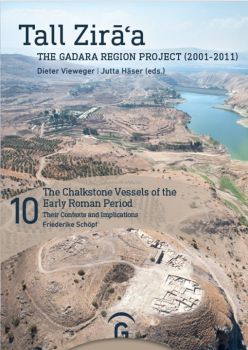Final Publication - Volume 10
|
|
|
Volume 10, The Chalkstone Vessels of the Early Roman Period
Friederike Schöpf
TABLE OF CONTENTS
Lists, Abbreviations
Preface, Acknowledgements,
Introduction by Friederike Schöpf
Bibliography
1. HISTORY AND METHODOLOGY
1.1. Terminology
1.1.1. Nation(s) and Nationalism / Ethnicity
1.1.2. Material Culture
1.1.3. Geographical Terms
1.1.4. Diaspora
1.1.5. Jew/Judaean/Israelite
1.2. Historical Background
1.3. Purity as an Identity Marker
2. JEWISH PURITY PRACTICES DURING THE LATE SECOND TEMPLE PERIOD
2.1. Defining Purity and Impurity
2.2. Practising Purity
2.3. The Hierarchy of Purity
2.4. Gentile Influences on Jewish Purity Practice
2.5. Individual Purity of the Rabbis and its Decline in Jewish Society
3. THE EMERGENCE OF PURITY LITERATURE
3.1. The First Phase of a New Purity Approach: Texts in the Tanakh
3.1.1. Ezekiel
3.1.2. Ezra and Nehemia
3.1.3. Conclusion
3.2. Entering the Private Sphere: Purity, Family and Individuals in the Apocrypha
3.2.1. Tobit
3.2.2. Judith
3.2.3. 1 Maccabees
3.2.4. Conclusion
3.3. Taking Purity to a New Level: The Dead Sea Scrolls
3.3.1. Separation from the Others and Unrighteous Jews
3.3.2. The Purity of the Temple
3.3.3. Corpse Impurity and the Impurity of Stone
3.3.4. Full-Body Immersion
3.3.5. Female Polluting Powers
3.3.6. Summary
3.4. Historical Sources: Josephus
3.5. Purity of the Soul: Diasporic Literature
3.5.1. The Letter of Aristeas
3.5.2. Philo of Alexandria (15/10 BC–45/50 AD)
3.6. Conclusion
4. ‘PURE’ MATERIAL CULTURE
4.1. Chalkstone Vessels
4.1.2. Vessel Types
4.1.3. Production Methods and Sites
4.1.4. The Significance of Chalkstone Vessels
4.2. Stone Ossuaries
4.2.1. The New Burial Custom
4.3. Pottery
4.4. Ritual Stepped Pools
4.5. Conclusion
5. THE EVIDENCE FROM TALL ZIRĀʿA
5.1. Tall Zirāʿa in its Regional Context
5.2. Archaeological Research from 2003–2011 and 2018–2019
5.2.1. Area I
5.2.2. Area II
5.2.3. Area III
5.2.4. The Classical Periods at Tall Zirāʿa
5.3. The Chalkstone Vessels
5.3.1. The Typology
5.3.1.1. Hand-carved Vessels
5.3.1.2. Lathe-turned Vessels
5.3.1.3. Fragments (Plates 5.45–5.47)
5.4. Contextualization of the Finds
5.4.1. Distribution in the Areas
5.4.2. The Find Contexts of Areas I, II, and III
5.4.3.1. Dating
5.4.3.2. Origin of Types
5.5. The Historical Context, or where did the Jews come from?
5.5.1. Rural Jewish Settlements in the Chora of the Decapolis
5.5.2. The Households in Tall Zirāʿa
5.5.3. Where is the Ritual Stepped Pool?
5.6. Summary
5.7. Catalogue and Plates
5.7.1. Hand-carved Vessels with Chisel Marks: Type I. A.
5.7.1.1. Mugs and Pitchers: Type I. A. Form 1. OV
5.7.1.2. Bowls: Type I. A. Form 2. OV
5.7.2. Polished Open Hand-carved Vessels: Type I. B.
5.7.2.1. Mugs and Pitchers: Type I. B. Form 1. OV
5.7.2.2. Bowls: Type I. B. Form 2. OV
5.7.3. Lathe-turned Vessels
5.7.3.1. Lathe-turned Bowls Type II. A.
5.7.3.2. Bowls with Decorative Strip/Handle: Type II. A. Form 2. Ove
5.7.4. Lathe-turned Vessels with Hand-carved Decoration: Type II. B. Form 1. OV
5.7.5. Fragments
5.7.5.1. Fragments of Hand-carved Vessels
5.7.5.2. Fragments of Lathe-turned Vessels
5.7.6. Unfinished Vessel from Ḥirbat al-Mukhayyaṭ
6. FINDS OF JEWISH MATERIAL CULTURE IN TRANSJORDAN
6.1. Peraea
6.1.1. Machaerus
6.1.2. Callirrhoë (‘Ain az-Zāra)
6.1.3. Tulūl aḍ-Ḍahab
6.1.4. Ḥirbat ‘Atarūz
6.1.5. Tall Nimrīn
6.1.6. Tall Abū Sarbut
6.1.7. al-Laǧǧūn
6.1.8. Tall al-Ḥammām
6.1.9. Wādī al-Kharrār
6.1.10. Ḥisbān/Ḥešbon/Esbous
6.1.11. Tall al-‘Umēri
6.1.12. Ḥirbet Umm ad-Danānīr
6.1.13. Beth Zar’a
6.2. On the Edge of Peraea
6.2.1. Madeba
6.2.2. Ḥirbat al-Mukhayyaṭ (Town of Nebo)
6.2.3. Mount Nebo Region
6.2.4. Tall as-Sa‘īdiya
6.3. Nabatean (Influenced) Regions
6.3.1. Ḥirbet al-Mudayna
6.3.2. Ed-Dēr
6.4. The Cities of the Decapolis
6.4.1. Abila
6.4.2. Gadara (Umm Qēs)
6.4.3. Pella
6.4.4. Gerasa/Ǧaraš
6.4.5. Philadelphia (Amman)
6.5. The North
6.5.1. Zeraqōn-Valley
6.5.2. Wādī al-‘Arab
6.6. Jewish Material Culture in Transjordan: Trade and Tradition
7. FINDS OF JEWISH MATERIAL CULTURE IN OTHER DIASPORA COMMUNITIES
7.1. Prayer Houses and Their Meaning for Purity
7.2. Material Culture and the Special Case of Egypt
7.2.1. Ostraca Find CG 125
7.2.2. Ossuaries and Tombs
7.3. Summary
8. PUTTING THE EVIDENCE TOGETHER: A NEW APPROACH TO PURITY
8.1. The Chronology of Purity
8.2. A Question of Identity
8.3. Summary and Conclusion
Bibliography
|
Project Partners |
|
Biblical Archaeological Institute Wuppertal (BAI) |
|
Patronage |
|
His Royal Highness Prince El Hassan bin Talal took up the patronage of this project as a representative of the royal house. |
Friends and Donors |
|
Cooperations |
|
We cooperate closely with many universities, institutes and companies.  |


 print version
print version
